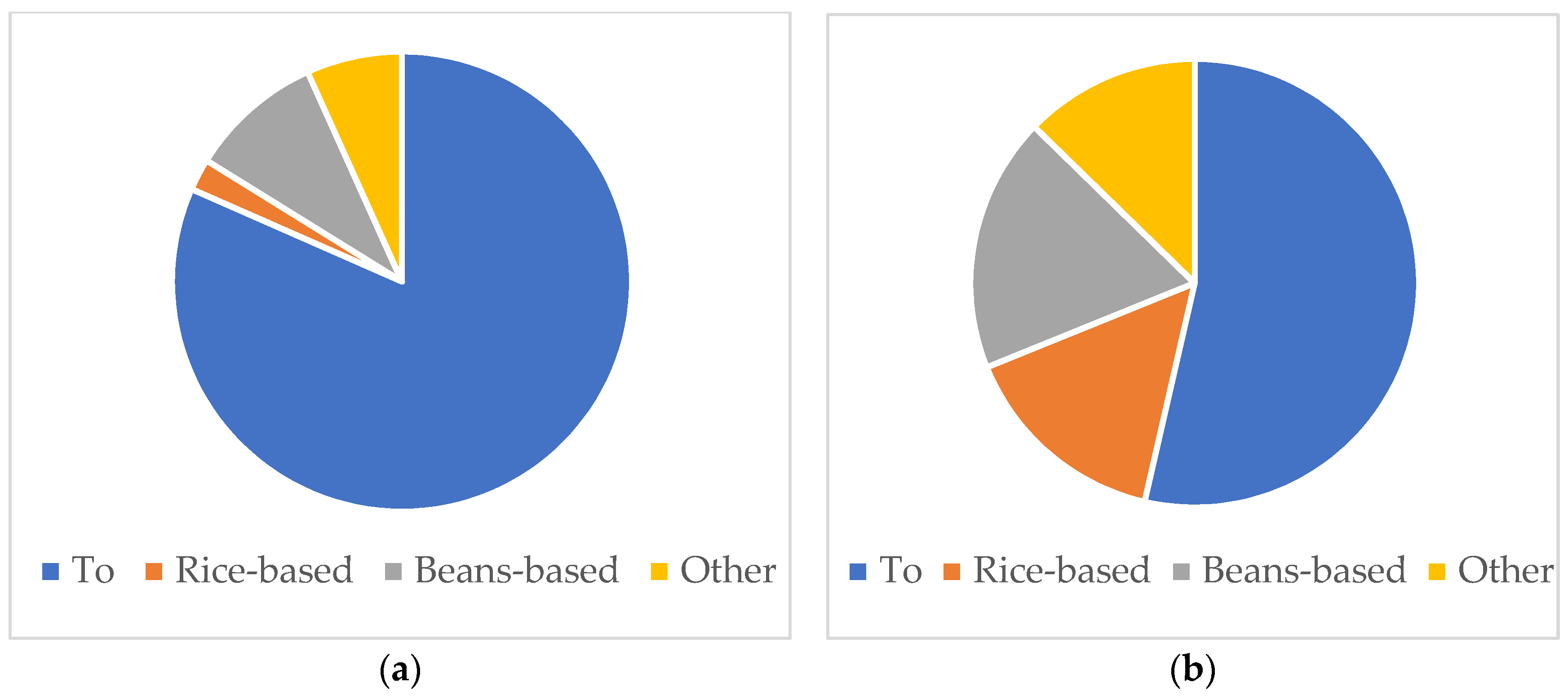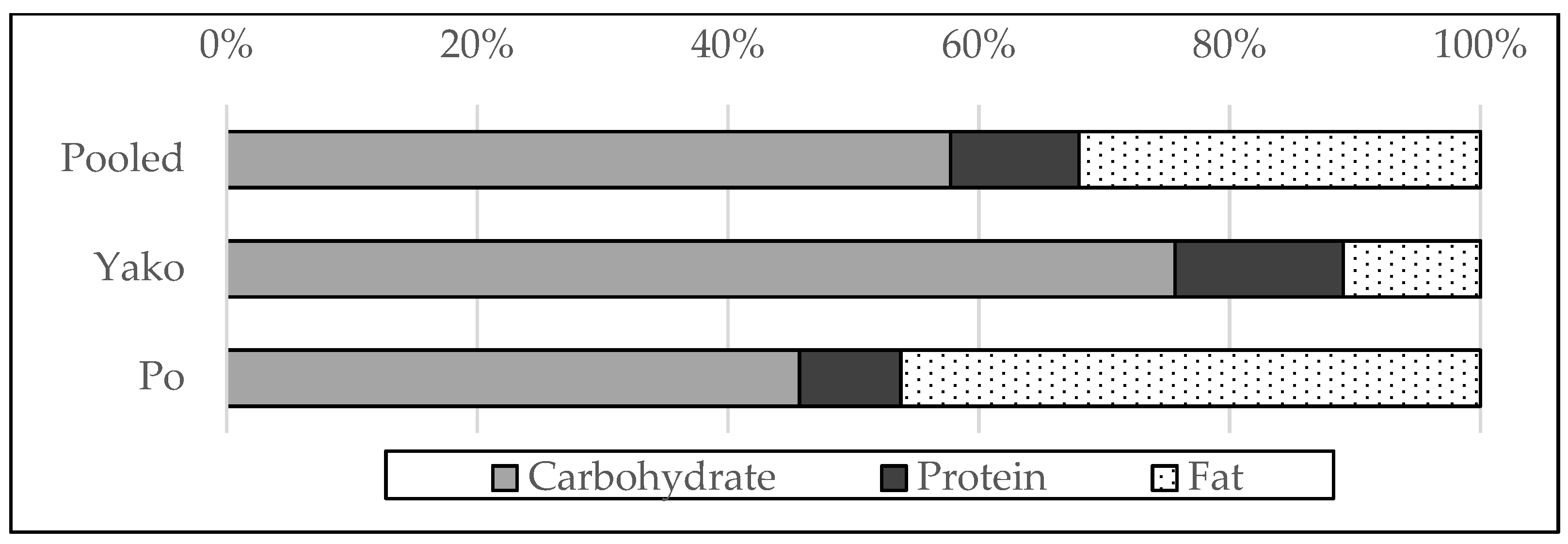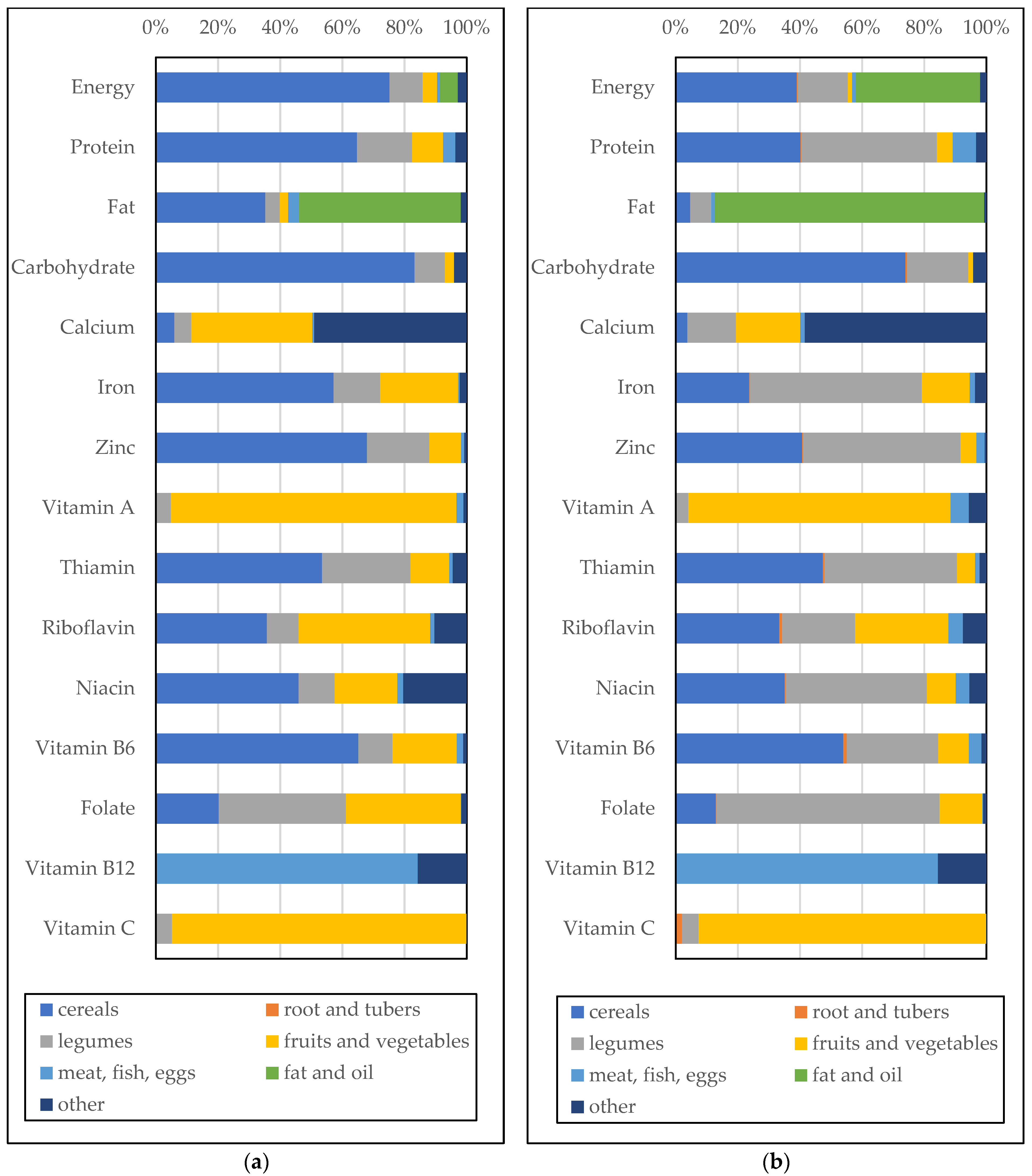Food Security, Nutritional Supply, and Nutrient Sources in Rural Burkina Faso
Abstract
1. Introduction
2. Materials and Methods
3. Results
3.1. Descriptive Statistics of the Households
3.2. Food Consumption Scores (FCS)
3.3. Recipes
3.4. Nutrient Supply
3.5. Macronutrient Balance
3.6. Food Groups Contributing to Nutrient Supply
4. Discussion
Author Contributions
Funding
Institutional Review Board Statement
Informed Consent Statement
Data Availability Statement
Acknowledgments
Conflicts of Interest
References
- FAO; IFAD (International Fund for Agricultural Development); UNICEF (United Nations International Children’s Emergency Fund); WFP (World Food Programme); WHO (World Health Organization). The State of Food Security and Nutrition in the World 2022: Repurposing Food and Agricultural Policies to Make Healthy Diets More Affordable; FAO: Rome, Italy, 2022; ISBN 978-92-5-136499-4. [Google Scholar]
- Development Initiatives the 2022 Global Nutrition Report: Stronger Commitments for Greater Action. Available online: https://globalnutritionreport.org/reports/2022-global-nutrition-report/ (accessed on 22 March 2023).
- Otten, J.J.; Hellwig, J.P.; Meyers, L.D. Dietary Reference Intakes: The Essential Guide to Nutrient Requirements; The National Academies Press: Washington, DC, USA, 2006; ISBN 0-309-65646-X. [Google Scholar] [CrossRef]
- Colen, L.; Melo, P.C.; Abdul-Salam, Y.; Roberts, D.; Mary, S.; Gomez, Y.; Paloma, S. Income Elasticities for Food, Calories and Nutrients across Africa: A Meta-Analysis. Food Policy 2018, 77, 116–132. [Google Scholar] [CrossRef]
- World Bank World Development Indicators|DataBank. Available online: https://databank.worldbank.org/source/world-development-indicators (accessed on 22 March 2023).
- Turowska, Z.; Buttarelli, E.; Sombié, I.; Nisbett, N.; Van den Bold, M.; Becquey, E. Stories of Change in Nutrition in Burkina Faso 1992–2018: A Macro-Level Perspective. Food Secur. 2023, 15, 535–554. [Google Scholar] [CrossRef] [PubMed]
- Waongo, M.; Laux, P.; Kunstmann, H. Adaptation to Climate Change: The Impacts of Optimized Planting Dates on Attainable Maize Yields under Rainfed Conditions in Burkina Faso. Agric. For. Meteorol. 2015, 205, 23–39. [Google Scholar] [CrossRef]
- Shiratori, S.; Sawadogo-Compaore, E.M.F.W.; Chien, H. Variation of Cowpea Production and Usage in Rural Households: A Comparison between Northern and Southern Burkina Faso. Jpn. Agric. Res. Q. JARQ 2020, 54, 263–270. [Google Scholar] [CrossRef]
- Fraval, S.; Yameogo, V.; Ayantunde, A.; Hammond, J.; de Boer, I.J.M.; Oosting, S.J.; van Wijk, M.T. Food Security in Rural Burkina Faso: The Importance of Consumption of Own-Farm Sourced Food versus Purchased Food. Agric. Food Secur. 2020, 9, 2. [Google Scholar] [CrossRef]
- Marivoet, W.; Becquey, E.; Van Campenhout, B. How Well Does the Food Consumption Score Capture Diet Quantity, Quality and Adequacy across Regions in the Democratic Republic of the Congo (DRC)? Food Secur. 2019, 11, 1029–1049. [Google Scholar] [CrossRef]
- FAO. GIEWS (Global Information and Early Warning System) Country Brief: Burkina Faso. Available online: http://www.fao.org/giews/countrybrief/country/BFA/pdf_archive/BFA_Archive.pdf (accessed on 31 January 2023).
- Becquey, E.; Delpeuch, F.; Konaté, A.M.; Delsol, H.; Lange, M.; Zoungrana, M.; Martin-Prevel, Y. Seasonality of the Dietary Dimension of Household Food Security in Urban Burkina Faso. Br. J. Nutr. 2012, 107, 1860–1870. [Google Scholar] [CrossRef] [PubMed]
- Arsenault, J.E.; Nikiema, L.; Allemand, P.; Ayassou, K.A.; Lanou, H.; Moursi, M.; De Moura, F.F.; Martin-Prevel, Y. Seasonal Differences in Food and Nutrient Intakes among Young Children and Their Mothers in Rural Burkina Faso. J. Nutr. Sci. 2014, 3, e55. [Google Scholar] [CrossRef]
- WFP (World Food Programme). Food Consumption Analysis, Calculation and Use of the Food Consumption Score in Food Security Analysis. Available online: https://documents.wfp.org/stellent/groups/public/documents/manual_guide_proced/wfp197216.pdf (accessed on 22 March 2023).
- INDDEX Project. Data4Diets: Building Blocks for Diet-Related Food Security Analysis; Tufts University: Boston, MA, USA, 2018. [Google Scholar]
- Leroy, J.L.; Ruel, M.; Frongillo, E.A.; Harris, J.; Ballard, T.J. Measuring the Food Access Dimension of Food Security: A Critical Review and Mapping of Indicators. Food Nutr. Bull. 2015, 36, 167–195. [Google Scholar] [CrossRef]
- Stadlmayr, B.; Charrondiere, U.R.; Enujiugha, V.N.; Bayili, R.G.; Fagbohoun, E.G.; Samb, B.; Addy, P.; Barikmo, I.; Ouattara, F.; Oshaug, A.; et al. West African Food Composition Table [Table de Composition des Aliments D’Afrique de L’Ouest]; FAO: Rome, Italy, 2012; ISBN 978-92-5-007207-4. [Google Scholar]
- David, B.H.; Jaspreet, K.C.A.; Xianli, W.; Meena, S.; Melissa, N.; Quyen, A.N.; Janet, M.R.; Juhi, R.W.; Kristine, Y.P.; Ying, L.; et al. USDA National Nutrient Database for Standard Reference, Legacy Release; Nutrient Data Laboratory, Beltsville Human Nutrition Research Center, ARS: Beltsville, MD, USA, 2019.
- Ministère de la santé Burkina Faso. Rapport de l’enquête Nationale sur la Prévalence des Principaux Risques Communs Aux Maladies Non Transmissibles au Burkina Faso: Enquête STEPS 2013. 2014. Available online: https://cdn.who.int/media/docs/default-source/ncds/ncd-surveillance/data-reporting/burkina-faso/steps/burkinafaso-2013-steps-report.pdf (accessed on 28 April 2023).
- Cafiero, C. Advances in Hunger Measurement Traditional FAO Methods and Recent Innovations; FAO Statistics Division; Working Paper Series ESS/14-04; FAO: Rome, Italy, 2014; pp. 1–27. [Google Scholar]
- FAO. FAOSTAT: Suite of Food Security Indicators. Available online: https://www.fao.org/faostat/en/#data/FS (accessed on 31 May 2021).
- Bennett, M.K. International Contrasts in Food Consumption. Geogr. Rev. 1941, 31, 365–376. [Google Scholar] [CrossRef]
- Herforth, A.; Ahmed, S. The Food Environment, Its Effects on Dietary Consumption, and Potential for Measurement within Agriculture-Nutrition Interventions. Food Secur. 2015, 7, 505–520. [Google Scholar] [CrossRef]
- HarvestPlus. HarvestPlus Biofortified Crops Map and Table Updated with 2020 Data. Available online: https://www.harvestplus.org/harvestplus-biofortified-crops-map-and-table-updated-with-2020-data/ (accessed on 22 March 2023).
- Ufuan Achidi, A.; Ajayi, O.A.; Bokanga, M.; Maziya-Dixon, B. The Use of Cassava Leaves as Food in Africa. Ecol. Food Nutr. 2005, 44, 423–435. [Google Scholar] [CrossRef]
- Douny, L. Conserving Millet with Potash: Towards a Dogon Epistemology of Materials. Tech. Cult. 2018, 69, 1–30. [Google Scholar] [CrossRef]
- Willett, W.; Rockström, J.; Loken, B.; Springmann, M.; Lang, T.; Vermeulen, S.; Garnett, T.; Tilman, D.; DeClerck, F.; Wood, A.; et al. Food in the Anthropocene: The EAT–Lancet Commission on Healthy Diets from Sustainable Food Systems. Lancet 2019, 393, 447–492. [Google Scholar] [CrossRef] [PubMed]




| Food Group | Examples | Weight |
|---|---|---|
| Main staples | Cereals, roots, and tubers | 2 |
| Pulses | Beans, peas, nuts | 3 |
| Vegetables | Vegetables, leaves | 1 |
| Fruit | Fruits | 1 |
| Meat and fish | Beef, pork, eggs, fish | 4 |
| Milk | Milk, dairy products | 4 |
| Sugar | Sugar, honey | 0.5 |
| Oil | Oil, fats, butter | 0.5 |
| Condiments | Spices, salt, coffee | 0 |
| Yako (% in Yako) | Po (% in Po) | Pooled (% in Pooled) | |||||
|---|---|---|---|---|---|---|---|
| Total number of households | 670 | - | 506 | - | 1176 | - | |
| Village | Gobila | 86 | (12.8) | - | 86 | (7.3) | |
| Gollo | 280 | (41.8) | - | 280 | (23.8) | ||
| Taonsgho | 304 | (45.4) | - | 304 | (25.9) | ||
| Pinyiri | - | 117 | (23.1) | 117 | (9.9) | ||
| Torem | - | 239 | (47.2) | 239 | (20.3) | ||
| Adongo | - | 150 | (29.6) | 150 | (12.8) | ||
| Survey round | Apr 2019 | 116 | (17.3) | 97 | (19.2) | 213 | (18.1) |
| June 2019 | 119 | (17.8) | 92 | (18.2) | 211 | (17.9) | |
| Aug 2019 | 116 | (17.3) | 71 | (14.0) | 187 | (15.9) | |
| Oct 2019 | 115 | (17.2) | 78 | (15.4) | 193 | (16.4) | |
| Dec 2019 | 105 | (15.7) | 80 | (15.8) | 185 | (15.7) | |
| Feb 2020 | 99 | (14.8) | 88 | (17.4) | 187 | (15.9) | |
| Household size | mean (SD) | 7.8 | (±4.0) | 6.5 | (±2.9) | 7.3 | (±3.7) |
| Under five child ratio | % (SD) | 11.8 | (±15.6) | 11.6 | (±13.7) | 11.7 | (±14.8) |
| Age of head | mean (SD) | 52.8 | (±15.0) | 50.5 | (±16.8) | 51.8 | (±15.8) |
| Gender of head | Male | 560 | (83.6) | 458 | (90.5) | 1018 | (86.6) |
| Female | 110 | (16.4) | 48 | (9.5) | 158 | (13.4) | |
| Ethnicity of head | Gouroussi | 0 | (0.0) | 400 | (79.1) | 400 | (34.0) |
| Mossi | 670 | (100.0) | 75 | (14.8) | 745 | (63.4) | |
| Other | 0 | (0.0) | 31 | (6.1) | 31 | (2.6) | |
| Religion of head | Christian | 431 | (64.3) | 201 | (39.7) | 632 | (53.7) |
| Muslim | 187 | (27.9) | 245 | (48.4) | 432 | (36.7) | |
| Animist | 52 | (7.8) | 54 | (10.7) | 106 | (9.0) | |
| Education of head | Never attended school | 572 | (85.4) | 331 | (65.4) | 903 | (76.8) |
| Attended school | 98 | (14.6) | 175 | (34.6) | 273 | (23.2) | |
| Languages the head understands | Mossi | 670 | (100.0) | 346 | (68.4) | 1016 | (86.4) |
| (Multiple answers) | Gouroussi/Kassena | 0 | (0.0) | 444 | (87.7) | 444 | (37.8) |
| French | 6 | (0.9) | 155 | (30.6) | 161 | (13.7) | |
| Ashanti | 0 | (0.0) | 45 | (8.9) | 45 | (3.8) | |
| Dioula | 6 | (0.9) | 26 | (5.1) | 32 | (2.7) | |
| Other | 0 | (0.0) | 35 | (6.9) | 35 | (3.0) | |
| Women’s plot | Yes | 188 | (28.1) | 71 | (14.0) | 259 | (22.0) |
| No | 482 | (71.9) | 435 | (86.0) | 917 | (78.0) | |
| Field size (ha) | mean (SD) | 1.9 | (±1.1) | 4.6 | (±2.6) | 3.0 | (±2.3) |
| Number of crops grown in 2019 | mean (SD) | 3.1 | (±1.1) | 4.7 | (±1.5) | 3.8 | (±1.5) |
| Coef. | Std. Err. | p-Value | |
|---|---|---|---|
| Season (base = Pre-harvest: June & August) | |||
| Middle (February & April) | 0.29 | 0.15 | 0.06 ** |
| Post-Harvest (October & December) | 0.48 | 0.16 | 0.00 *** |
| Commune (1 = Yako, 0 = Po) | −3.11 | 0.39 | 0.00 *** |
| Gender of Head (1 = Male, 0 = Female) | −0.17 | 0.22 | 0.43 |
| Age of Head | 0.04 | 0.03 | 0.15 |
| Age of Head Squared | 0.00 | 0.00 | 0.11 |
| Religion of Head (base = Other) | |||
| Muslim | 0.80 | 0.20 | 0.00 *** |
| Christian | 0.31 | 0.17 | 0.07 ** |
| Ethnicity of Head (base = Other) | |||
| Mossi | −0.09 | 0.53 | 0.87 |
| Gouroussi | −0.17 | 0.43 | 0.70 |
| Education of Head (1 = Attended, 0 = Never attended school) | 0.43 | 0.19 | 0.03 ** |
| Household Size | −0.03 | 0.02 | 0.22 |
| Under 5 Child Ratio | −0.64 | 0.47 | 0.17 |
| Number of crops grown in 2019 | −0.02 | 0.06 | 0.73 |
| Women’s plot (1 = Yes, 0 = No) | 0.60 | 0.21 | 0.01 *** |
| /Cut1 | −2.46 | 0.82 | |
| /Cut2 | −0.94 | 0.82 | |
| Log likelihood Function | −910.59 | ||
| Wald Chi-Squared | 465.28 | ||
| Pseudo R2 | 0.23 | ||
| Number of Observations | 1175 | ||
| Yako | Po | p-Value | Pooled | EAR | Cor. with FCS | ||||
|---|---|---|---|---|---|---|---|---|---|
| Mean | SD | Mean | SD | Yako & Po | Mean | SD | |||
| Energy (kcal) | 778.2 | 537.9 | 1529.8 | 922.0 | (0.000) | 1101.6 | 817.8 | 2225 (i) | 0.34 |
| Macronutrients | |||||||||
| Carbohydrate (g) | 141.7 | 91.5 | 168.6 | 69.6 | (0.000) | 146.1 | 153.2 | 83.8 | 0.21 |
| Protein (g) | 26.1 | 22.1 | 31.0 | 18.1 | (0.000) | 28.2 | 20.6 | 40.9 | 0.16 |
| Micronutrients | |||||||||
| Calcium (mg) | 386.4 | 620.0 | 390.7 | 395.8 | (0.217) | 388.2 | 535.0 | 800.0 | 0.10 |
| Iron (mg) | 11.7 | 18.4 | 9.6 | 7.8 | (0.000) | 10.8 | 14.9 | 7.1 | 0.03 |
| Zinc (mg) | 4.8 | 3.6 | 5.7 | 4.0 | (0.000) | 5.2 | 3.8 | 8.1 | 0.13 |
| Vitamin C (mg) | 20.0 | 22.6 | 22.5 | 20.5 | (0.007) | 21.1 | 21.7 | 67.5 | 0.10 |
| Thiamin (mg) | 0.7 | 0.8 | 1.1 | 0.7 | (0.000) | 0.9 | 0.8 | 1.0 | 0.21 |
| Riboflavin (mg) | 0.5 | 1.1 | 0.4 | 0.3 | (0.112) | 0.4 | 0.8 | 1.0 | 0.01 |
| Niacin (mg) | 5.2 | 18.9 | 6.3 | 4.7 | (0.000) | 5.7 | 14.6 | 11.5 | 0.12 |
| Vitamin B6 (mg) | 0.9 | 1.0 | 1.0 | 0.5 | (0.000) | 0.9 | 0.8 | 1.1 | 0.13 |
| Folate (μg) | 212.4 | 385.1 | 340.0 | 345.4 | (0.000) | 267.3 | 373.7 | 320.0 | 0.14 |
| Vitamin B12 (μg) | 0.2 | 0.2 | 0.3 | 0.5 | (0.000) | 0.2 | 0.4 | 2.0 | 0.20 |
| Vitamin A (μgRAE) | 60.8 | 99.3 | 53.4 | 64.4 | (0.243) | 57.6 | 86.1 | 562.5 | 0.10 |
Disclaimer/Publisher’s Note: The statements, opinions and data contained in all publications are solely those of the individual author(s) and contributor(s) and not of MDPI and/or the editor(s). MDPI and/or the editor(s) disclaim responsibility for any injury to people or property resulting from any ideas, methods, instructions or products referred to in the content. |
© 2023 by the authors. Licensee MDPI, Basel, Switzerland. This article is an open access article distributed under the terms and conditions of the Creative Commons Attribution (CC BY) license (https://creativecommons.org/licenses/by/4.0/).
Share and Cite
Shiratori, S.; Tobita, Y.; Sawadogo-Compaoré, E.M.F.W. Food Security, Nutritional Supply, and Nutrient Sources in Rural Burkina Faso. Nutrients 2023, 15, 2285. https://doi.org/10.3390/nu15102285
Shiratori S, Tobita Y, Sawadogo-Compaoré EMFW. Food Security, Nutritional Supply, and Nutrient Sources in Rural Burkina Faso. Nutrients. 2023; 15(10):2285. https://doi.org/10.3390/nu15102285
Chicago/Turabian StyleShiratori, Sakiko, Yachiyo Tobita, and Eveline M. F. W. Sawadogo-Compaoré. 2023. "Food Security, Nutritional Supply, and Nutrient Sources in Rural Burkina Faso" Nutrients 15, no. 10: 2285. https://doi.org/10.3390/nu15102285
APA StyleShiratori, S., Tobita, Y., & Sawadogo-Compaoré, E. M. F. W. (2023). Food Security, Nutritional Supply, and Nutrient Sources in Rural Burkina Faso. Nutrients, 15(10), 2285. https://doi.org/10.3390/nu15102285







